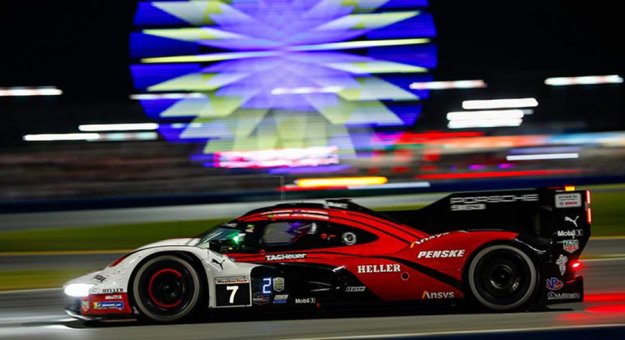DAYTONA BEACH, Fla. — The degree of difficulty made the accomplishment even more significant.
In just its 10th IMSA WeatherTech SportsCar Championship race under the hybrid-based Grand Touring Prototype (GTP) format, Porsche Penske Motorsport claimed the series’ most momentous race. Days after winning the 62nd Rolex 24 At Daytona, drivers Dane Cameron and Matt Campbell continued to praise the team for the achievement.
“This is our biggest race,” Cameron said. “It’s our Super Bowl if you’re an American fan. It’s our Indy 500, our Monaco. Whatever you want to call it, this is our version of it. … In our environment, this is our big one.”
Cameron, Campbell, Felipe Nasr and Josef Newgarden combined to put the No. 7 Porsche Penske Motorsport Porsche 963 in victory lane on Jan. 28, giving team owner Roger Penske his first overall victory in the 24-hour race at Daytona since 1969.
The origins of the win were rooted in the results of the previous Rolex 24. There, in the debut of the new GTP car, Porsche Penske’s two entries finished seventh and eighth in class. Afterward, the team set off on a journey to improve.
“We sat down and looked at the aspects of the car that we really wanted to focus on,” Campbell said. “We felt like we didn’t have the raceability to be able to attack and actually pass cars. Now we sort of more or less have that.”
The complicated new GTP specifications created a massive challenge in 2023 for all four competing manufacturers – Porsche, Acura, BMW and Cadillac. Near the end of the season, though, the two Porsche Penske 963s became fast and forceful, winning at Road America and Indianapolis.
“The consistency really started to prove itself toward the end of the year,” Campbell said. “The car groups were working extremely well together, and obviously there was a big increase in performance from the middle half of last year toward the end. It’s carried across into this year.”
Both cars were stout at Daytona, with the No. 6 – co-driven by Nick Tandy, Mathieu Jaminet, Laurens Vanthoor and Kevin Estre – finishing fourth.
“Now we really feel like we have more or less a proper race car – a lot closer to the competition in this respect for raceability,” Campbell said. “This was a big difference compared to last year at Daytona. For sure, this was one of our weakest points. Now it’s one of our more positive and strong points.”
The praise for that improvement, the drivers said, goes to the brains behind the operation – Team Penske president and strategist for the No. 7 car Tim Cindric, Porsche Penske managing director Jonathan Diuguid, competition director Travis Law and lead engineer Raul Prados.
“A lot of these guys I’ve worked with for a number of years,” said Cameron, who joined Penske’s sports car team in 2018. “That kind of development curve that we went through on the last program to the development of this car, there’s been a lot of work – countless hours from numerous people to put this thing in a position to win a race like this.”
The WeatherTech Championship season resumes March 16 with the Mobil 1 Twelve Hours of Sebring. And while the Porsche Penske team will head to Sebring Int’l Raceway on a victory high, it will only serve as inspiration to achieve more.
“It’s all about momentum,” Cameron said. “Winning helps everything, but the competition is still stiff, just like it was last year. We’ll take some of the learnings from Daytona and try to apply them. It’s a constant development process with software and other systems. Every time we race, we learn something.”
